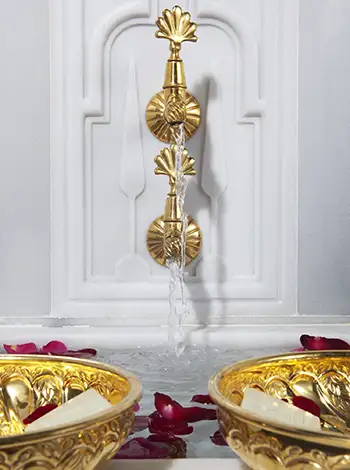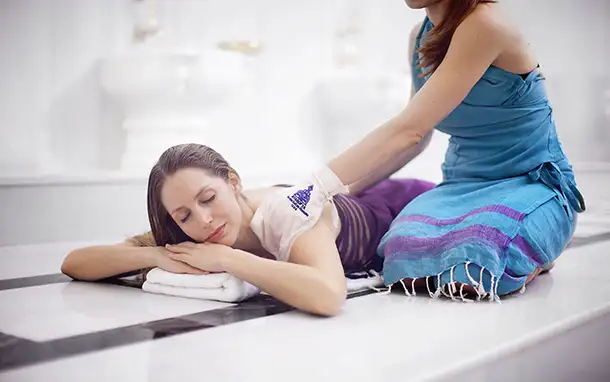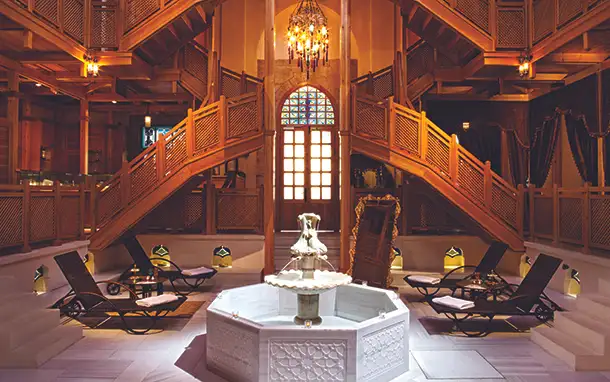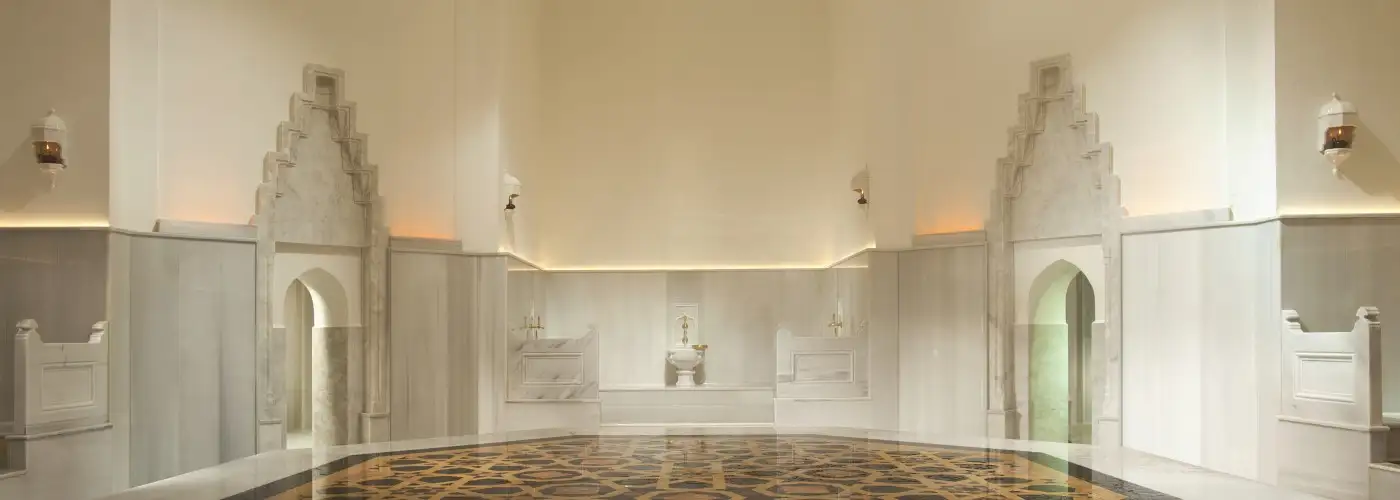Maybe it was the brochure images of reclining models wrapped in embroidered linen. Maybe I had failed to sufficiently research Turkish bathing traditions. Whatever the reason, I was taken unawares when the attendant ripped my towel off, exposing me to a group of strangers in an exquisite marble room.
Phase one of Pir-i Pak, the traditional full cleanse at Istanbul’s Ayasofya Hurrem Sultan Hammam, calls for the bather to sit bare on one of the white marble benches in a steamy, high-ceilinged chamber. I learned this fast, plunging into communal nudity the way one dives into a cold pool of water.

Historically, collective nakedness is not without function: According to legend, women availed of Turkish spas to examine prospective wives’ unclad bodies on behalf of male relatives. While the history of public bathing is rooted in ancient Rome, Turkish baths, or hammams, became popular under the Ottoman Empire and came to function as an important social and religious ritual within Turkish culture. I was sitting in the hammam built by Suleyman the Magnificent in 1556. It was originally constructed as a bathhouse for Suleyman’s wife, Hurrem Sultan, also known as Roxelana. Born a slave, Roxelana rose from obscurity to wield tremendous political influence in the Ottoman Empire. Rejecting the tradition of producing heirs through concubines, Suleyman wed Roxelana and gave up his harem. She is the first woman in history to officially marry an Ottoman sultan—a true-life Cinderella. The ritual I was about to experience was the same one that the celebrated sultana and her court would undergo in Roxelana’s personal hammam.
The attendant, now holding my towel, barked a single command: “Sit.” Using a gold-plated bowl, she scooped warm water from a marble basin and poured it over my head and body. Through a veil of water, I saw sunlight streaming through apertures in the domed ceiling. Ladies lounged on stone, dousing their skin with ladles of heated water. I learned later that the spa was built on the site where the Temple of Zeus once stood. Indeed, the place looked like an earthly approximation of a god’s bathroom, staffed by forceful attendants who defeated language barriers with pushy hands and militant monosyllabic orders. I think Zeus would approve.
 This is not me.
This is not me.
If you don’t voluntarily disrobe upon entering the hammam, the attendant will correct you. My towel was taken without regard for any puritanical American habits I might bear. This no-nonsense handling continued as we entered a second chamber for step two of my treatment: the ritual body scrubbing. And what a scrubbing it was. With a cotton cloth, the attendant scoured every inch of my body, lifting an arm or a leg whenever necessary. I was naked. Others in the room underwent the exfoliating treatment simultaneously, and we could all see each other. We were naked. The takeaway here is that you should skip the traditional full cleanse if a stranger forcefully buffing your exposed breasts as you sit hunched on a marble slab might stress you out. It’s not for the modest.
Step three furthered the flagrant nudity. Back in the first chamber, five or six bare women lay, head-to-foot, around the edge of a large circular marble platform in the center of the room. I joined them, completing the circle. The attendant applied big puffs of bubbles to my body, like the teeming suds that take over your kitchen when you put the wrong kind of soap in the dishwasher. I became a cloud of effervescence on a bed of warm marble. Next came a rinse, followed by a full-body massage and hair washing. At this final stage of the ritual cleansing, any slight misgivings about public nudity I may have had were out with the bathwater.
 The lobby of the Ayasofya Hurrem Sultan Hammam. You can wear clothes here.
The lobby of the Ayasofya Hurrem Sultan Hammam. You can wear clothes here.
If You Go
At the end of the treatment, bathers are presented with a bag containing the cotton scrub used to exfoliate them, some products, and slippers. I hadn’t brought makeup, clean underwear, or hair products, and I definitely wished I had thrown some of those items into my purse. Bring whatever essentials you typically apply after a shower, whether it’s moisturizer, sunscreen, or hair serum.
The Ayasofya Hurrem Sultan Hammam is located in a highly trafficked spot between the Blue Mosque and the Hagia Sophia. Although the Turkish-bath tradition has been a popular local custom for centuries, expect to see mostly tourists bathing alongside you; these historical public baths don’t see the high numbers of locals that used to frequent their chambers before daily showers and Western spa treatments became standard. The full cleanse lasts 35 minutes and costs 85 euros. Other packages are available.
You Might Also Like:
- Turkish Adds New Service with Remarkably Cheap Fares to Europe
- Here’s Why It’s Now a lot Easier to Travel to Turkey
- Best Airlines for Free Stopovers
We hand-pick everything we recommend and select items through testing and reviews. Some products are sent to us free of charge with no incentive to offer a favorable review. We offer our unbiased opinions and do not accept compensation to review products. All items are in stock and prices are accurate at the time of publication. If you buy something through our links, we may earn a commission.
Related
Top Fares From
Today's Top Travel Deals
Brought to you by ShermansTravel
France: 8-Night Paris, Avignon & Nice...
Infinity Worldwide Vacations
 vacation
$2880+
vacation
$2880+
Poconos: 3 Nts in Garden of...
ResortsAndLodges.com
 hotel
$305+
hotel
$305+
7-Nt Canada & New England Cruise,...
Princess Cruises
 cruise
$839+
cruise
$839+




